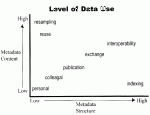Metadata - What It Is
Whether you’ve either just heard about metadata in ecology or you’re tired of hearing about the subject, this complicated topic can either fire up a conversation or cause the whole group to scatter. Whatever the response -- it is a remarkable evolution from just a decade ago when metadata was something discussed only behind the closed doors of musty computer labs in the closest of a company of data managers.
Metadata is data about data that data managers try to accumulate without inconveniencing PIs. And to data managers it is considered to be of equal importance to data themselves. Once called ‘data documentation’ it bore the unsavory connotation of lots of work for no thanks. Strategies for extracting it from the memories of scientists were frequently among the topics of discussion. It would require considerable detective work to find more than a casual mention of documenting data in early LTER data management publications. But nonetheless, LTER information managers were working on standards then for the purpose of making sure that LTER data could be understood and used well into the future.
And that future is now.
The first implementation of a standardized set of metadata came with the development of the first LTER data catalog1 -- this was the first attempt to integrate a minimum set of information about each LTER data set. Content standards were formally established in 1994 and became the precursor to standards published 19972. While these standards described for the user the minimum components that should be included to adequately document a data set for exchange, no recommendation was made about implementation or structure. More elaborate exchange standards for metadata were discussed off and on but it wasn’t until the WWW happened that the realization occurred about what was possible with structured metadata. New uses such as internet-based data integration and interoperability became plausible because developers were no longer saddled with the task of writing client software for multiple computer platforms -- a task that has discouraged many.
Looking at functional metadata requirements reveals something approximating the graph in Figure 1. It becomes quite clear that structure is extremely important for enabling data integration and interoperability but content is more important for insuring future viability.
At their annual meeting in August, the LTER Information Managers established a new working group whose goal it is to develop LTER standards for ecological metadata. LTER efforts for years have been focused on the long-term stewardship of the data -- assuring for their reuse in the future. With this new Metadata Standards Working Group and the development of new partnerships LTER information managers will make great strides toward increasing the use and accessibility of the wealth of ecological data produced by LTER, and subsequently promoting ecological science.
Further Reading
- Long-Term Ecological Research Network Core Data Set Catalog. 1990. Michener, W.K. (ed), Miller, A.B. (ed), Nottrott, R. (ed).Belle W. Baruch Institute for Marine Biology and Coastal Research: University of South Carolina, Columbia, SC, USA. 322 pp.
- Non-geospatial metadata for the ecological sciences. 1997. William K. Michener, James W. Brunt, John J. Helly, Thomas B. Kirchner, and Susan G. Stafford. Ecological Applications 7:330-342. D

 Enlarge this image
Enlarge this image
